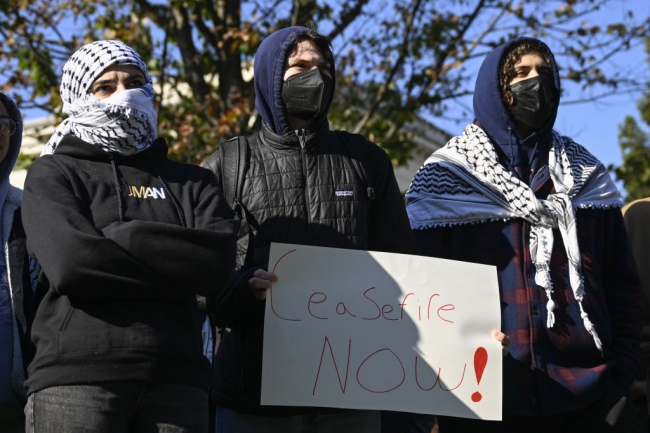You have /5 articles left.
Sign up for a free account or log in.

Students at American University protest Israel’s military actions in Gaza Nov. 1, 2023.
Celal Gunes/Anadolu/Getty Images
According to the recent opinion piece entitled “Are Students Embracing Ignorance? Or Violence?” written by Moti Mizrahi, slogans and chants used by students at pro-Palestinian demonstrations “expose the failures of higher education” and indicate that we have failed to teach students either “historical and philosophical context” or “tolerance and nonviolence.” While I agree that we can find examples of how higher education may be failing students, I disagree with Mizrahi about the cause and nature of those failures.
I read this opinion piece on the same day that I saw the video of Israel’s destruction of Gaza’s “last standing university,” Al-Israa University, approximately two months after Israeli soldiers took over the campus and began using it for their own military purposes. In addition to the university, a national museum near the campus that had housed more than 3,000 rare artifacts was also destroyed.
Letter to the Editor
A reader has submitted
a letter in response to this
article. You can read
the letter here, and view
all of our letters to the
editor here.
Since Israel began its military aggression, more than 25,000 Palestinians have been killed, and—in addition to the ongoing violence and the desperate conditions of displaced, unsheltered people living without adequate food, water, sanitation or medical care—hospitals, universities, schools, libraries, museums, cultural centers, mosques, churches and sites of historical importance and heritage are being destroyed. And whereas in the past, many academic institutions may have issued statements or responses expressing support or solidarity, such as was the case when Russia invaded Ukraine, the lack of institutional responses to the destruction of Gaza and to the devastation and suffering of the Palestinian people is notable.
Likewise in the United States, I have not seen any institutional statements from universities expressing grief over the destruction of Gaza’s universities or verbalizing condemnation of the targeting of educational institutions. And as someone who has worked in higher education for more than two decades and who has (perhaps naively) believed in the ideals we claim to uphold, that silence has been painfully loud.
Instead, it is common for more academic and media attention to be given to demonstrators saying “from the river to the sea” (a phrase that is often demonized when used to express support for equal rights for Palestinians) than to what is actually happening to the Palestinian people in Gaza and the occupied West Bank—people who are literally not safe or free, no matter where they seek shelter, in any location “from the river to the sea.” At the same time, it is rarely scrutinized or commented on when Israeli officials and military leaders call for an expansion of Israeli control from the river to the sea, words that are accompanied by the ongoing violent displacement and expulsion of the Palestinian people from their land and homes.
There is a palpable dissonance when the dominant conversation in many academic circles is centered on demonizing students who express solidarity with Palestinians and who are calling for a ceasefire rather than examining the complicit support for actual U.S. government–funded violence and ongoing destruction. Mizrahi states that we have failed to teach students “that a violent struggle against injustice is cowardly, whereas a nonviolent struggle is courageous,” while at the same time he ignores and disregards the actual violence against Palestinians that the students are (nonviolently) protesting against. To me, this suggests that perhaps it is not the students who need to learn this lesson.
Language is increasingly weaponized and information is shared in the mainstream media within a framework reliant on racist tropes that present Palestinians as terrorists and calls for Palestinian freedom as inherently antisemitic. Meanwhile, more and more academic or public events featuring Palestinian speakers, writers and artists are being canceled or deemed too controversial to host. Speaking about Palestinian rights and equality, or criticizing U.S. and Israeli policy and actions, or even just being Palestinian are frequently regarded as controversial, a perception that is having a chilling effect on academic institutions throughout the country.
Rather than upholding the ideals of academic freedom, rather than creating spaces for students to counter misinformation, to ask important questions, to express themselves and apply what they are learning to the larger world, institutions are banning pro-Palestinian student groups or canceling events, such as the recent art retrospective by Palestinian artist Samia Halaby that had been scheduled to take place at Indiana University before the provost noted that the show carried “a risk of violence.”
Yes, we are letting our students down, but not because, as Mizrahi suggests, we are letting “misinformation on Tik Tok inform their judgments,” a dismissive comment that minimizes how students engage with social media, but rather because we are afraid to create spaces for them to engage critically with information from all sources, be it Tik Tok, CNN, Al Jazeera or the federal government. We should be teaching students, and also learning ourselves, how to recognize and explore the impacts of racism and bias on the ways in which information is shared and communicated.
And we—as individuals, students, teachers and staff—should also examine how that knowledge impacts our actions. We should be asking questions like: Who gets to speak and who is being represented? Who is believed and who is questioned? Who is centered and who is ignored? Who stands to benefit from the information being shared and who is harmed? Is there a power dynamic embedded within the framing of the information being shared and what is the impact of that dynamic? What information is being highlighted and what is being obscured or excluded? Is a false equivalency being presented to create the perception of neutrality or a lack of bias?
As communities of higher education, we should be engaging with the world around us by actually applying the information and media literacy skills, critical thinking abilities, and academic values we claim to uphold and support. If we cannot do this, we are failing much more than our students.








